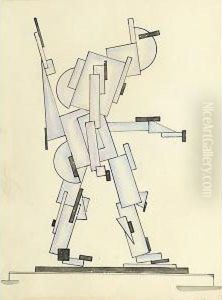David Yakerson Paintings
David Yakerson, born in 1896 in Vitebsk, then part of the Russian Empire and now in Belarus, was a significant painter and graphic artist associated with the Jewish art movement of the early 20th century. His works, deeply rooted in the Jewish cultural and religious traditions, reflect the tumultuous times he lived through, including the World Wars, the Russian Revolution, and the rise of the Soviet Union. Yakerson's artistic journey began in his hometown, which was also the birthplace of Marc Chagall, another prominent Jewish artist. The cultural vibrancy and the rich Jewish heritage of Vitebsk significantly influenced Yakerson's early works.
Yakerson's education in art took place amidst the backdrop of significant historical upheavals. He studied at the Vitebsk Art School, where he was exposed to various avant-garde movements and artists, including Kazimir Malevich and El Lissitzky, who were also connected with the school at different times. Despite this exposure, Yakerson's art remained deeply connected to his Jewish roots, often depicting scenes from Jewish life, folklore, and the Bible. His style evolved over time, incorporating elements of Expressionism and Cubism, but always maintaining a distinct narrative quality that spoke to the Jewish experience.
In the 1920s and 1930s, Yakerson's work began to gain recognition beyond his immediate surroundings. However, his career faced significant challenges due to the oppressive political climate of the Soviet Union, particularly under Stalin's regime, when Jewish cultural expressions were increasingly suppressed. Despite these challenges, Yakerson continued to produce art that celebrated Jewish identity and heritage, making significant contributions to Jewish art history.
The outbreak of World War II and the subsequent horrors of the Holocaust had a profound impact on Yakerson's life and work. The war years brought untold suffering to the Jewish community, including Vitebsk, which was occupied by Nazi Germany. Yakerson's fate during this period is a reflection of the tragic experiences of many Jewish artists and intellectuals of his time. He died in 1945, leaving behind a body of work that stands as a poignant testament to the resilience of Jewish culture and the indomitable spirit of an artist who remained dedicated to his roots amidst the greatest adversities.
David Yakerson's legacy, though not as widely recognized as some of his contemporaries, is an important chapter in the history of Jewish art. His works are preserved in various collections and continue to be studied for their unique contribution to the understanding of the Jewish experience through art, particularly during one of history's darkest periods.
